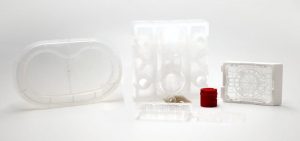Fluoropolymers Are A Great Choice For Parts That Must Perform In Unique Conditions
May 19, 2022 | Blog, Capabilities Blogs, FEP & PFA Materials Blog, Videos
When you need parts that can withstand extreme operating conditions, fluoropolymers may fit the bill. Parts like roofing membranes, fuel tubes, biomedical devices, and wires are all common applications of fluoropolymers.
FEP Fluoropolymer:
Fluorinated ethylene propylene (FEP resin) is a melt-processable fluoropolymer. FEP has low gas and permeability properties, can be extruded in long continuous lengths, and possesses excellent UV transmission rating. FEP is also suitable for use in a biomedical setting and is gamma sterilizable.
All of these attributes make FEP an ideal fluoropolymer for a diverse range of applications from environmental monitoring equipment to medical devices and electronics. Because it is a thermoplastic, FEP is also easily heat-formed, tipped, tapered, flared, and flanged.
PFA Fluoropolymer:
Perfluoroalkoxy (PFA resin) is a melt-processable fluoropolymer that combines many of the best traits of PTFE and FEP. At 500 °F (260 °C), PFA has a higher service temperature than FEP and maintains its mechanical integrity in extreme temperatures even when exposed to caustic chemicals. PFA has greater tensile strength than PTFE and a smoother surface finish than both PTFE and FEP.
PFA’s is a top choice in semiconductor, chemical, oil and gas, aerospace, automotive, pharmaceutical, and medical industries. This fluoropolymer has excellent lubricity, clarity, flexibility, and chemical resistance, making it a versatile choice.
FEP vs PFA Fluoropolymers
FEP and PFA are injection moldable, highly inert, compatible with most organic compounds, have good barrier properties and high continuous use temperatures. They are virtually impervious to chemical, enzyme and microbiological attack and stiffer than PTFE. The non-stick properties of these polymers can also be useful to reduce liquid, gel and powder adhesion. Fluoropolymers in general, have good dielectric properties and are resistant to atmospheric degradation.
While significantly less expensive than PFA, FEP is very difficult to mold due to its low viscosity. However, Performance Plastics has developed proprietary tooling and processes enabling the injection molding of small, thin-walled, complex FEP parts.
• More transparent than PTFE (not injection moldable)
• Better gas and vapor permeability properties than PTFE
• Maximum working temperature 400°F
• Approximately 1/3 the cost of PFA
PFA is significantly easier to mold than FEP, however, it is significantly more expensive.
• Higher continuous service temperature than FEP
• Maximum working temperature 500°F
• Difference in molecular structure gives PFA improved flow, creep resistance and thermal stability.
At Performance Plastics, we are experts in injection molding, specializing in high performance plastics. Our proprietary tool design software, processes and equipment enable us to injection mold components having complex geometries made from challenging ultra, high-performance thermoplastic materials, and reinforced compounds. For more information on Performance Plastic’s capabilities, please contact Rich Reed, Vice President of Sales and Marketing at 513.321.8404 or email at [email protected]






